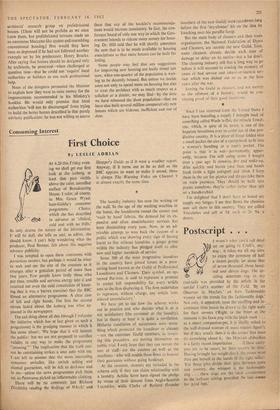Design
Uphill Work
Ity KFNNETH J, ROBINSON
EVERY working day one thousand families in England move into newly finished• houses or flats. That, according to our new Housing Minister. Dr. Charles Hill, is not good enough. He told delegates to the recent Westminster con- ference of the Society of Housing Managers that he was not satisfied with the country's hous- ing. It was not just the quantity of homes he was complaining about; it was quality as well. 'Houses,' he told his audience, in a phrase that will doubtless echo inspiringly among the nation's tee-squares and trowels, 'are for people.' Many of today's houses, he considered, did not seem to have been designed for people's requirements at -all. There was a need, he added, in a burst of rhetoric that suggested he was not quite sure who or where he was, 'for a new wind of design.'
Dr. Hill is new to his job and it is natural that he should imitate one of his predecessor's tire- some little habits. But although Henry Brooke was continually criticising the country's housing— until we forgot that he, as Minister in charge of it, ought to do. something about it himself—he never stuck his neck out quite as far as Dr. Hill. The new Minister went so far as to tell his audi- ence—practical men and women from local authorities all over the country—that he was in favour of higher standards of housing, includ- ing things like better appearance, larger floor areas and improved methods of heating. He said that local authorities should study his Ministry's publication Homes for Today and Tomorrow and that he would supply them with bulletins on such matters as improved play areas and better refuse-disposal systems. None of these happy words was lost in a succession, of hearty cheers. In fact, the housing managers were torn be- tween enthusiasm for the improvements in stand- ards advocated by the Minister and frustration at his failure to explain where the money for such improvements was to come from.
Many delegates were clearly impressed by Hugh Wilson's illustrated lecture on his work as architect to the remarkable New Town of Cumbernauld, a Scottish hill-top town where the new wind of design has reached gale force. Mr. Wilson showed that he was already putting into practice some of the housing improvements the Minister advocated, including, more play areas and garages, better house-warming, larger storage space and estate planning which separated pedestrians• from traffic. He said that, although his department's housing experiments had been carried out within the normal budget, thanks to hard work and imaginative design- ing, a general improvement in housing standards could result only from larger funds, new tech- niques of prefabrication and a wider use of architects.
Delegates would not, perhaps, have been so disappointed by the Minister's speech if he had told them of the work already being clone by his architects' research group on prefabricated houses. (These will not be prefabs as we once knew them, but prefabricated terraces made on an enormous Meccano-like system and resembling conventional housing.) Nor would they have been so depressed if he had not followed another example set by his predecessor, Henry Brooke. After saying that houses should be designed only by architects, he protested—when challenged at question time—that he could not 'require' local authorities or builders to use such professional help.
None of the delegates persuaded the Minister to explain how they were to raise money for the improvements recommended in his Ministry's booklet. He would only promise that local authorities 'will not be discouraged' from trying to build the better homes described in that purely advisory publication: he was not willing to assure them that any of the booklet's recommenda- tions would become mandatory. In fact, the con- ference heard of only one way in which the Gov- ernment intends to release more money for hous- ing. Dr. Hill said that he will shortly announce the sum that is to be made available to housing associations so that more houses can be built for letting.
Some people may feel that any suggestions for improving new housing are badly timed just now, when one-quarter of the population is wait- ing to be decently housed. But unless we decide soon not only to spend more on housing but also to treat the architect with as much respect as a solicitor or a doctor, we may find--by the time we have rehoused the slum population—that we have also built several million comparatively new houses which are hideous, inefficient and out of date.


































 Previous page
Previous page